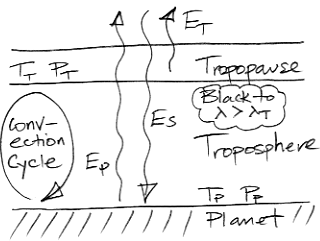
In our new model, the atmosphere continues to infinite altitude, getting thinner and thinner as we go. The lowest layer of the atmosphere is the troposphere. Above the troposphere is the tropopause. The tropopause is the layer that radiates heat into space. Above the tropopause, the atmosphere is so thin that it is transparent.
For now, we ignore day and night, and we ignore clouds. We ignore heat flowing through the solid mass of the planet. Short-wave radiation arriving from the sun passes straight through the atmosphere and is of uniform and constant power ES. The temperature and pressure at the planet surface are Tp and Pp respectively. A near-adiabatic convection cycle carries heat up through the troposphere to the tropopause, where it is radiated into space. The temperature and pressure of the tropopause are TT and PT respectively.
In our Extreme Greenhouse, the atmosphere was entirely opaque to all long-wave radiation. In our new Planetary Greenhouse, the atmosphere is transparent to all radiation with wavelength less than some threshold, λT. At greater wavelengths, a trace greenhouse gas in the atmosphere absorbs radiation. The greater the concentration of this greenhouse gas, the shorter the absorption length of the atmosphere for wavelengths greater than λT. As we saw in The Upper Gas, the shorter the absorption length, the lower the tropopause pressure. As we saw in Atmospheric Convection, the lower the tropopause pressure, the lower its temperature.
As in our Extreme Greenhouse, we assume that the planet radiates like a black body. The radiation it emits below λT passes out into space. This radiated power is EP. As we described in Black Bodies, we can use Plank's Law to determine the power radiated at all wavelengths, so we can calculate the power radiated below λT as a function of TP.
The atmospheric convection cycle allows us to calculate the temperature of the tropopause given only TP and the ratio PT/PP. The tropopause radiates power ET into space. Using Plank's Law and radiative symmetry, we can calculate the power radiated by the tropopause as a function of TT. The atmosphere emits radiation only at wavelengths greater than λT.
For thermal equilibrium, we must have the total power radiated outward by the body and the tropopause equal to the total power arriving from the sun. Thus we must have ES = EP + ET. And so we arrive at a robust model of the planetary greenhouse effect when the greenhouse gas has a step-like absorption spectrum. Given only λT and PP, we can plot a graph of EP + ET versus temperature. This graph crosses ES at the equilibrium value of TP. We wrote a computer program to calculate EP + ET versus TP for a range of tropopause pressures. You will find the program here.
In our next post, we will choose useful values for λT and ES, and we will see how doubling the concentration of our greenhouse gas affects the temperature of the planet.

No comments:
Post a Comment